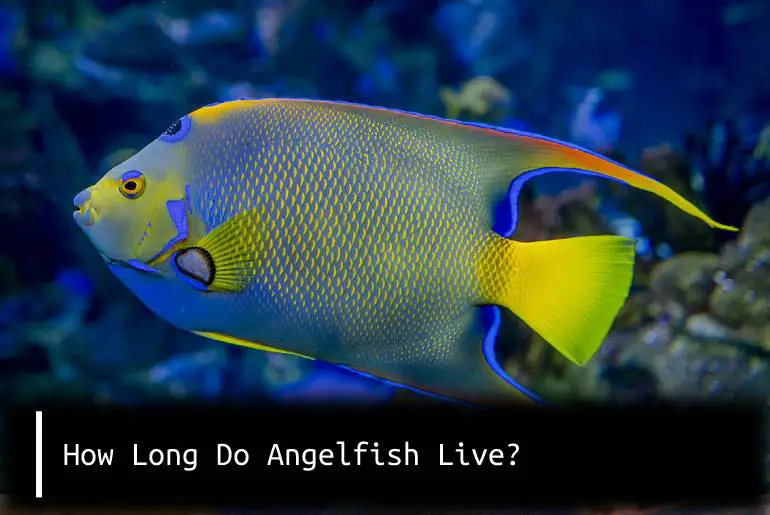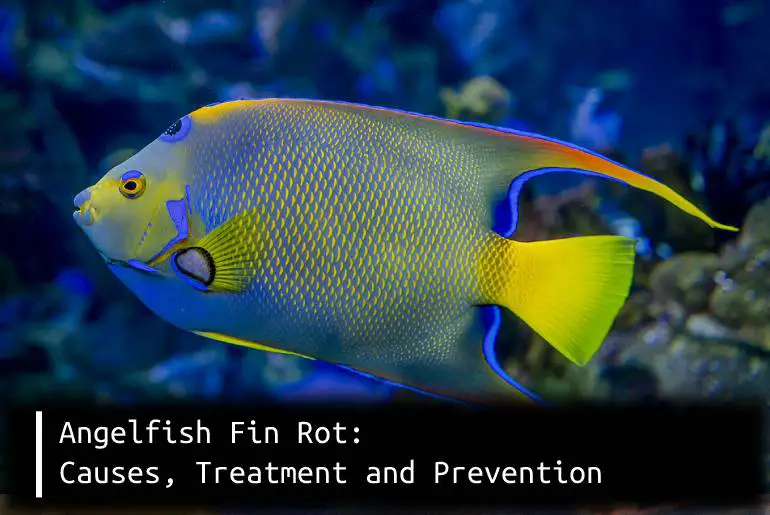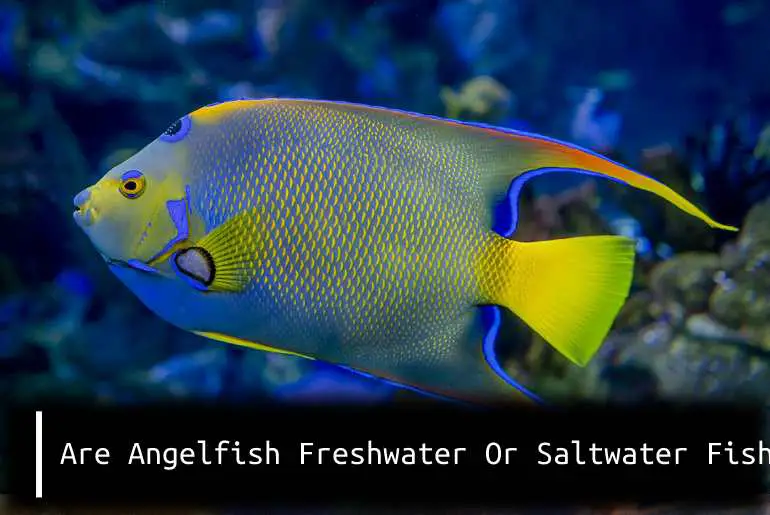When you are new to fishkeeping, you make many mistakes. And, if you keep fish like angelfish that aren’t the hardiest, then even a small mistake can cause big problems. The most common consequence of your mistake is angelfish death which is a heartbreaking experience for any fishkeeper, especially a beginner. So, how can you save a dying angelfish?
Some ways to save a dying angelfish are to quarantine the fish, identify and treat the underlying cause, make changes to the tank, and provide supportive care. Being cautious about your angelfish diet, water quality, and stress levels are also important to prevent mortality.
In addition to this, you can also use some home remedies to treat infectious diseases in your angelfish.
I will discuss with you everything about saving a dying angelfish in this article so that you can be prepared for any eventuality. So, let’s get started!
But before that, let me make you clear about how much angelfish can live and what causes their death first.
What Type Of Fish Is Angelfish?
Usually, angelfish are beautiful and multicolored, of two types: freshwater and saltwater. But in the aquarium trade, mostly freshwater angelfish are found. Angelfish are very popular aquarium fish because of their unique shape, lovely colors, and ease of keeping.
Freshwater angelfish come from South America in the Amazon River Basin. These fish are found in slow-moving waters and still pools of rivers. The different species of angelfish can be found in various colors like blue, yellow, green, red, orange, silver, and black. Some angelfish also have stripes or patterns on their body.
Usually, these angelfish are omnivores, and in the wild, they feed on small invertebrates, algae, and plant matter. But if you fail to take care of their diet in the aquarium, they might not survive for long.
So, how long will angelfish live then?
How Much Do Angelfish Live?
Angelfish have an average lifespan of about five to seven years. However, in the wild, their lifespan is often shorter due to predation and other factors. If you want your angelfish to live a long and healthy life, it’s important to provide them with the best possible care.
But their life expectancy differs as per the species. In general, freshwater angelfish are of three types scalare, leopoldi, and altum. Scalare angelfish is the most common type of freshwater angelfish and lasts about ten years. The leopoldi angelfish has a lifespan of about five to ten years. And altum angelfish has a lifespan of about fifteen years.
So, if you’re wondering how long angelfish live, the answer is that it depends on the species, but angelfish can live for up to fifteen years with proper care.
After knowing about the lifespan of angelfish, let’s know a little about the cause of their death.
Why Are Angelfish Dying?
After getting an angelfish, you surely want it to stay with you for a long time. But sometimes, things happen, and your angelfish might start dying. Seeing your angelfish dying is the most heartbreaking thing to happen to an owner. And you would want to save them, don’t you?
But to save your angelfish from dying, you first need to address the root cause: why are your angelfish dying?
Here are some of the most common reasons:
Lack Of Food
A lack of food is one of the most common reasons your angelfish might die. Some angelfish are known to be finicky eaters, and if they don’t get their favorite food, they might just starve themselves to death.
In addition to this, sometimes a novice owner might not know how much to feed their angelfish, and they possibly end up overfeeding or underfeeding them. This can also lead to your angelfish dying.
Unbalanced Diet
Being an omnivore, your angelfish needs both plants and meat to survive. If you’re only feeding them one or the other, they might not be getting the proper nutrition they need, and this can lead to their death. Your angel needs a well-balanced diet to stay healthy and live a long life.
Poor Water Quality
Water quality is vital for the well-being of angelfish. As mentioned above, angelfish are freshwater fish, and they need clean, fresh water to live. But sometimes, the water might not be as clean as it should be, and this can lead to your angelfish dying.
Some of the things that can affect water quality are:
- Ammonia levels
- Nitrate levels
- Nitrite levels
If any of these levels are too high or too low, it can lead to your angelfish dying.
Inadequate Housing
Angelfish are known to be territorial fish, and they need plenty of space to swim around. If you’re keeping them in a small tank, they might not have enough room to move, and this can stress them out. In addition to this, a small tank might not have enough filtration to keep the water quality high, and this can also lead to your angelfish dying.
Inappropriate Tankmates
You also must be careful about the fish you keep with your angelfish. Some fish are known to be aggressive, and they might pick on your angelfish. This can stress them out and lead to their death.
Some fish might not do well with other fish, which can lead to tank problems. Too big fish like oscar fish can eat your angelfish too. And also, too small fish like neon tetras can get eaten by your angelfish. So, you must be careful about the fish you keep with your angelfish.
Diseases
Lastly, diseases are also a common cause of death in angelfish. Some diseases are contagious, and they can spread quickly through a tank. Other diseases might be caused by poor water quality or a lack of food.
Whatever the reason might be, it’s important to address the problem as soon as possible. If you don’t, your angelfish might die.
However, even if you address the problem, sometimes it becomes very hard to save your angelfish from dying. So, what can you do to save your angelfish from dying, then?
How To Save A Dying Angelfish?
Death is a natural process. Everyone must face it at some point. Even fish are not exempt from this rule. In fact, your fish might leave way earlier than you think. But it is not common for your angelfish to die before the five-year mark if you take care of it properly.
However, if you notice your angels dying too early, something might be wrong with how you care for them. So, here are some guidelines that can help you to save your dying fish:
Quarantine Your Fish
When you get new fish, it is important to quarantine them first. This will help to prevent any diseases from spreading to your other fish. To do this, you will need a separate tank for the new fish. Put the new fish in this tank and observe them for at least two weeks. You can treat them if they show any signs of illness before adding them to the main tank.
Furthermore, you must also quarantine the sick fish. This will stop the illness from spreading and infecting the other fish. In addition to this, keeping ill angelfish in a separate tank will make it easier to treat them.
Increase Water Temperature
A slight increase in water temperature is great for boosting your fish’s immune system. Also, this will help them to fight off diseases more effectively. The ideal temperature for angels is between 77 and 86 degrees Fahrenheit.
So, keeping a temperature of 82 degrees Fahrenheit is ideal for most angelfish. You can use a heater to maintain this temperature in your tank. Slightly hot water will kill bacteria and other parasites that might be present in the water.
Monitor Water Conditions
The water your angelfish live in can affect their health. So, you should closely monitor the water’s temperature, pH levels, and hardness. You can use a water testing kit to check these conditions. If the levels are not ideal, take steps to adjust them.
The appropriate water temperature for angelfish is between 76 and 82 degrees Fahrenheit. The pH level should be between six and eight, and the hardness should be between 54 and 154 ppm.
Change The Water
If your angelfish is dying, you should change the water immediately. You can do a partial water change of about 20 to 25 percent. This will help remove toxins from the water and improve its water quality.
You should also clean the filter and remove any debris from the tank. This will help to keep the water clean and free of toxins. However, I suggest changing the water slowly and gradually to avoid shocking your fish.
Feed Them Properly
Your angelfish need a well-balanced diet to stay healthy. You should feed them high-quality food that is rich in nutrients. Many commercially available foods are specifically designed for angelfish. You can also give them live or frozen food such as brine shrimp or bloodworms.
Angelfish also need vegetables in their diet. You can give them blanched spinach, zucchini, or kale. These vegetables are a good source of vitamins and minerals.
You should also feed your angelfish small meals several times daily instead of one large meal. This will help to prevent indigestion and keep them healthy.
Some of your choices can consist of:
- Omega one pellets
- Ocean Nutrition Instant Baby Brine Shrimp 0.7-Ounces (20 Grams) Jar
- Omega One Freeze-Dried Blood Worms, 0.96 oz
- 200 Live Daphnia by Aqua L’amourl
- Hikari Bio-Pure Freeze Dried Daphnia for Pets, 0.42-Ounce
- Hikari Tubifex Worms Fish Food (0.7 oz.) [Set of 2]
Use Antioxidants And Medications
Like humans, some of the illness of angelfish requires medication. So, you can use antibiotics and other medications to treat your fish. You can also use antioxidants to help boost your fish’s immune system. This will help them to fight off diseases more effectively.
Other medications like methylene blue can also be used to treat fungal and bacterial infections. You can also use this medication to prevent these infections from occurring in the first place. You can also use vitamins and supplements to help your fish stay healthy. Vitamins C and E are great for boosting the immune system. Similarly, omega-three fatty acids are good for their skin and scales.
These are some of the medications that can be helpful for your angelfish:
- API MELAFIX Freshwater Fish Bacterial Infection Remedy 16-Ounce Bottle
- API AQUARIUM SALT Freshwater Aquarium Salt 16-Ounce Box
- Instant Ocean Reef Crystals Reef Salt For 160 Gallons, Enriched Formulation For aquariums
Provide Them With A Safe Environment
Angelfish need a clean and safe environment to thrive. You should keep their tank clean and free of toxins. You should also provide them with hiding places such as caves or plants. This will help them to feel secure and reduce stress levels.
You should also avoid using harsh chemicals such as chlorine in the tank. These chemicals can be harmful to your fish and lead to death. Some other medications are oxytetracycline, erythromycin, and kanamycin.
Keep Angelfish With Appropriate Tankmates
Angelfish need to be kept with appropriate tankmates. They are peaceful fish and do well with other peaceful fish. However, they can become aggressive if they are kept with fish that are too small or slow-moving.
Some good tankmates for angelfish include gouramis, tetras, barbs, rainbows, and danios. You should avoid keeping them with fish that are aggressive or too small.
Monitor Their Health
You should closely monitor your angelfish for signs of illness. If you notice any changes in their behavior or appearance, take them to the vet immediately. Early intervention is key to saving a sick fish.
These are just some of the things you can do to save your dying angelfish. If you take care of them properly, they will live a long and healthy life.
How To Know Your Angelfish Is Dying?
Although angelfish show prominent signs before dying, sometimes the owners fail to recognize them. Mostly when you are new to angelfish, you might get confused with their unusual behaviors. I too, used to think that my angelfish was acting weird and wacky sometimes, but it turned out that those were the signs of a dying angelfish.
To help you from not repeating my mistakes, here are a few things that will indicate that your angelfish is dying:
Loss of Appetite
If your angelfish do not eat anything for more than two days, then it’s a sign that something is wrong. It generally happens because the fish is not feeling well and has lost its appetite. Stress can also be a reason for the loss of appetite in angelfish.
Coloration
The color of your angelfish is one of the first things that will indicate whether it’s healthy or not. If you notice that your fish’s colors are fading, then it’s a sign that your fish is not doing well. Also, if you see any white spots on the body of your fish, then it’s a sign of disease, and your fish might be dying.
Behavior
The behavior of your angelfish is another thing that will indicate its health. If you notice that your fish is swimming erratically or lying at the bottom of the tank, then it’s not a good sign. These are the signs that your fish is sick and might be dying.
Immobility
If your angelfish is not moving at all and just lying at the bottom of the tank, then it’s a sign that it’s dying. This usually happens when the fish is suffering from some disease or infection. When your angelfish is dying, it feels tired and doesn’t have the energy to move around.
White Spots On the Skin
When your angelfish is going to die, you might notice some white spots on its skin. White patches on the skin can also be a sign of fungal infection, which is quite common in angelfish. In addition to this, you can also notice swelling, redness, and ulcers on the skin of your angelfish. All these things indicate that your angelfish is not doing well and might be dying.
Flared And Clamped Fins
If you notice that the fins of your angelfish are flared or clamped, then it’s a sign that your fish is in pain. This happens because the fish cannot swim properly and has trouble breathing.
When you see any change in their fins, it might be a sign of a bacterial infection or a disease. So, you should take immediate action to save your fish.
These are a few things that will indicate that your angelfish is dying. If you notice any of these signs, then it’s time to take action and save your fish.
Frequently Asked Questions
What Are The Most Common Cause Of Death In Angelfish?
The most common cause of death in angelfish is a disease. Infectious diseases such as bacterial infections, viruses, and parasites can quickly kill an entire school of fish. Other common causes of death include poor water quality, lack of food, and predation.
What Are The Best Conditions For Angelfish?
Angelfish thrive in warm, freshwater environments. These fish need plenty of space to swim and plenty of hiding places to feel secure. A well-oxygenated aquarium with a moderate water flow is ideal. Angelfish also need a diet that is high in protein, as they are carnivorous fish.
What Are The Common Treatments For Angelfish?
The most common treatments for angelfish are antibiotics, antifungals, and antiparasitics. These medications can be administered through water or injected into the fish. If the cause of the sickness is poor water quality, then making some changes to the aquarium environment can often help to cure the fish.
How Can I Prevent My Angelfish From Getting Sick?
The best way to prevent your angelfish from getting sick is to keep a clean and well-maintained aquarium. Regular water changes and filtration will help to keep the water quality high. Quarantining new fish before adding them to the main aquarium can also help prevent disease spread.
Conclusion
Wrapping up, if you think your angelfish is dying, there are a few things you can do to save them. First, check the water parameters and make sure they are within the ideal range. Second, look for signs of illness and treat it accordingly. Lastly, provide plenty of hiding places and a good diet. If you follow these steps, you should be able to save your angelfish.
If you think your angelfish is dying, do not despair. There are several things you can do to save it. With the right care, your angelfish can make a full recovery and live a long and healthy life.
If you have any further questions about how to save a dying angelfish, please feel free to contact us. We would be more than happy to help you.
We hope this guide has been helpful. Good luck!
Happy Angelfishing!






